Abstract
In recent decades, pediatric medicine has undergone a shift in focus from infectious diseases to the effects of behavior on the health and development of children. At the same time, behavior analysts have increasingly evaluated the direct application of their technology to the development and maintenance of child health behavior. Unfortunately, applied behavior analysts have developed their technology parallel to, rather than collaboratively with, pediatricians and, as a result, are not recognized as experts in the treatment of child health behavior. In addition, behavioral technology is not widely recognized as the treatment of choice by pediatricians. This paper provides a behavioral prescription for behavior analysts who wish to enter pediatrics as expert scientists and technicians. Specific recommendations are provided for stimulating collaborative rather than parallel development between applied behavior analysis and pediatrics in the promotion and maintenance of child health behavior. Strategies for maintaining this collaborative relationship and for strengthening the social relevance of behavior analysis are discussed.
Full text
PDF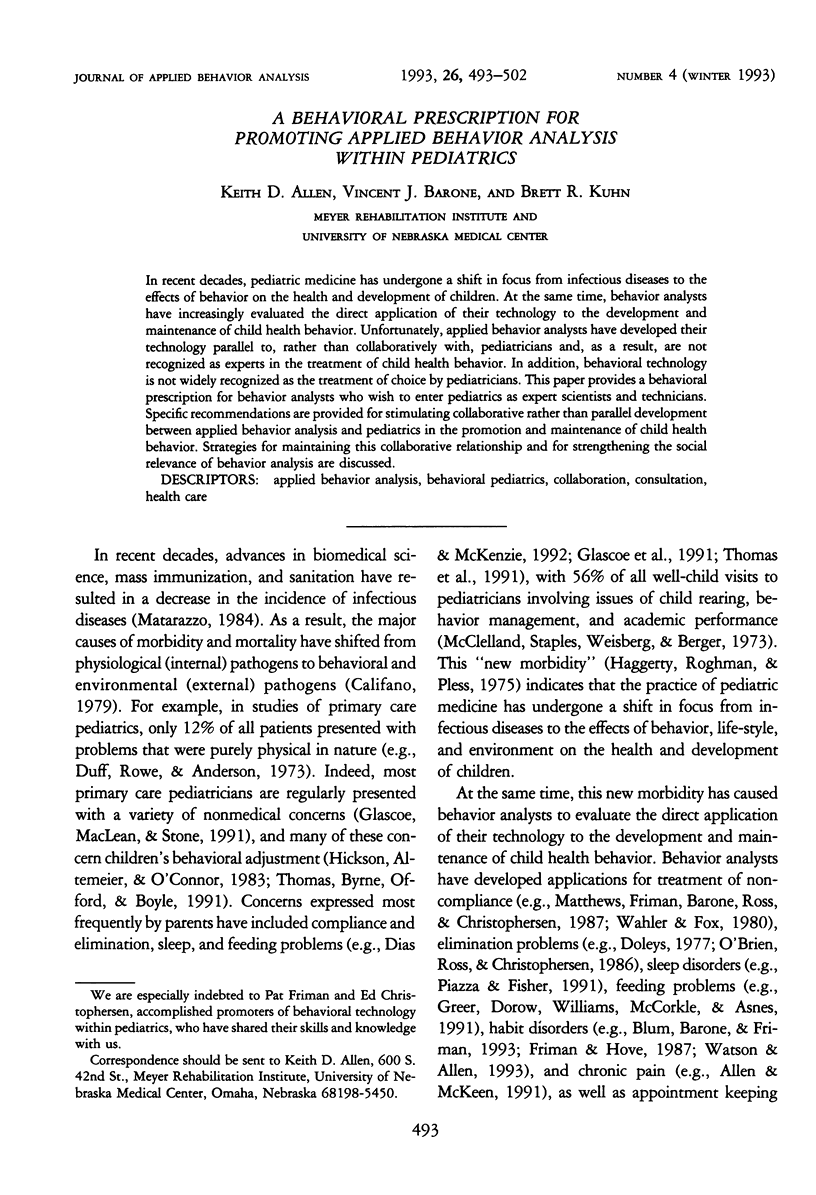

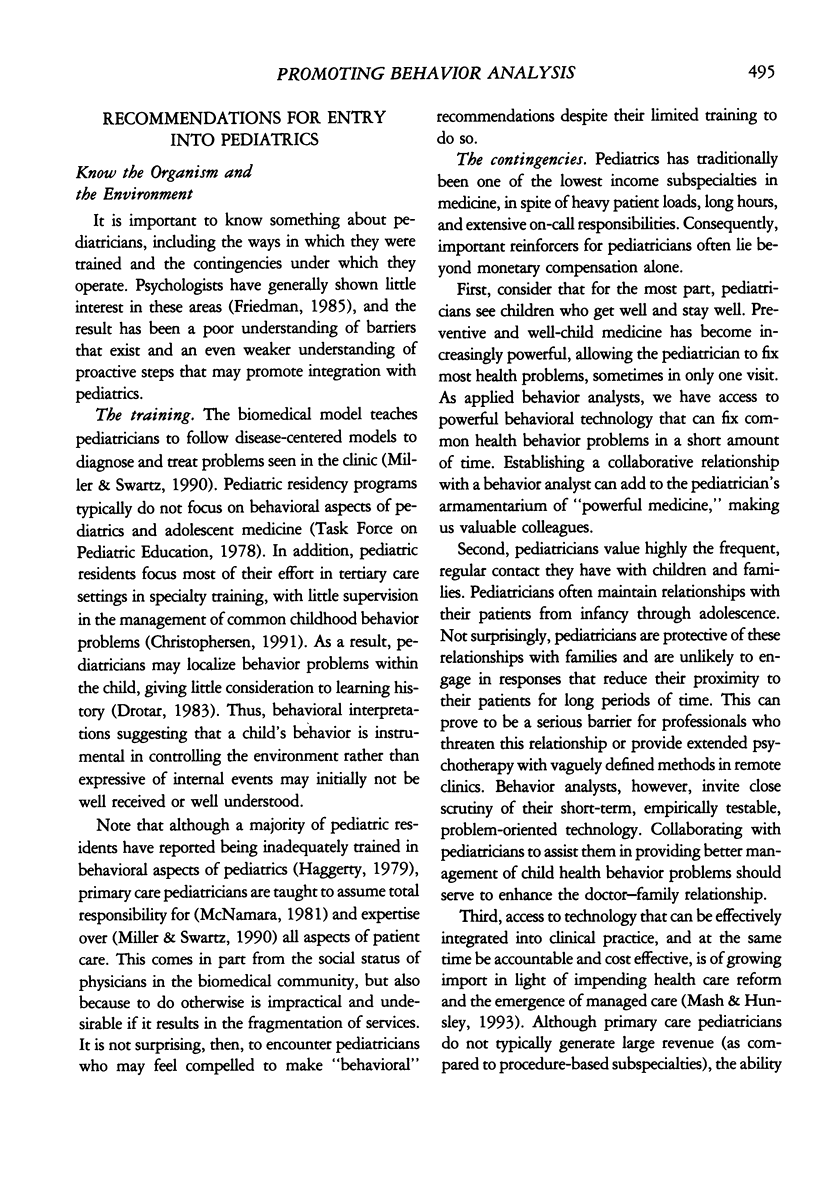
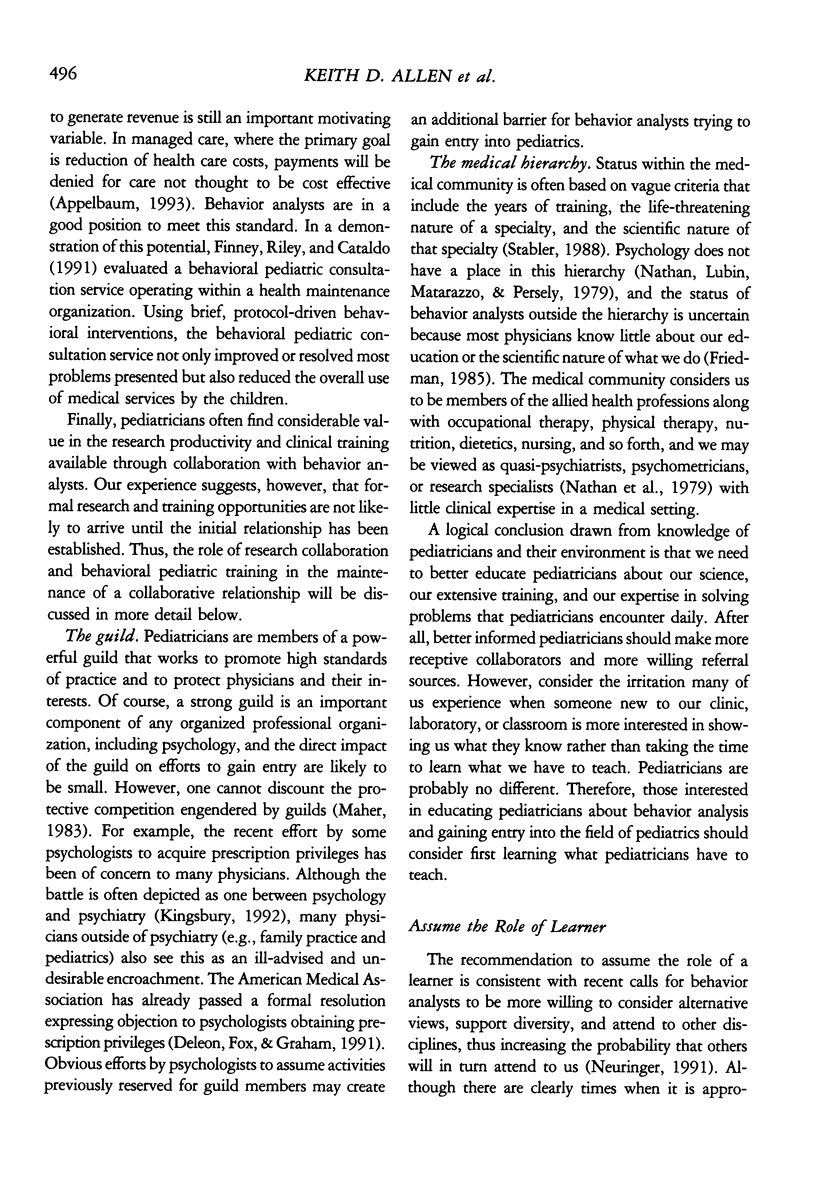

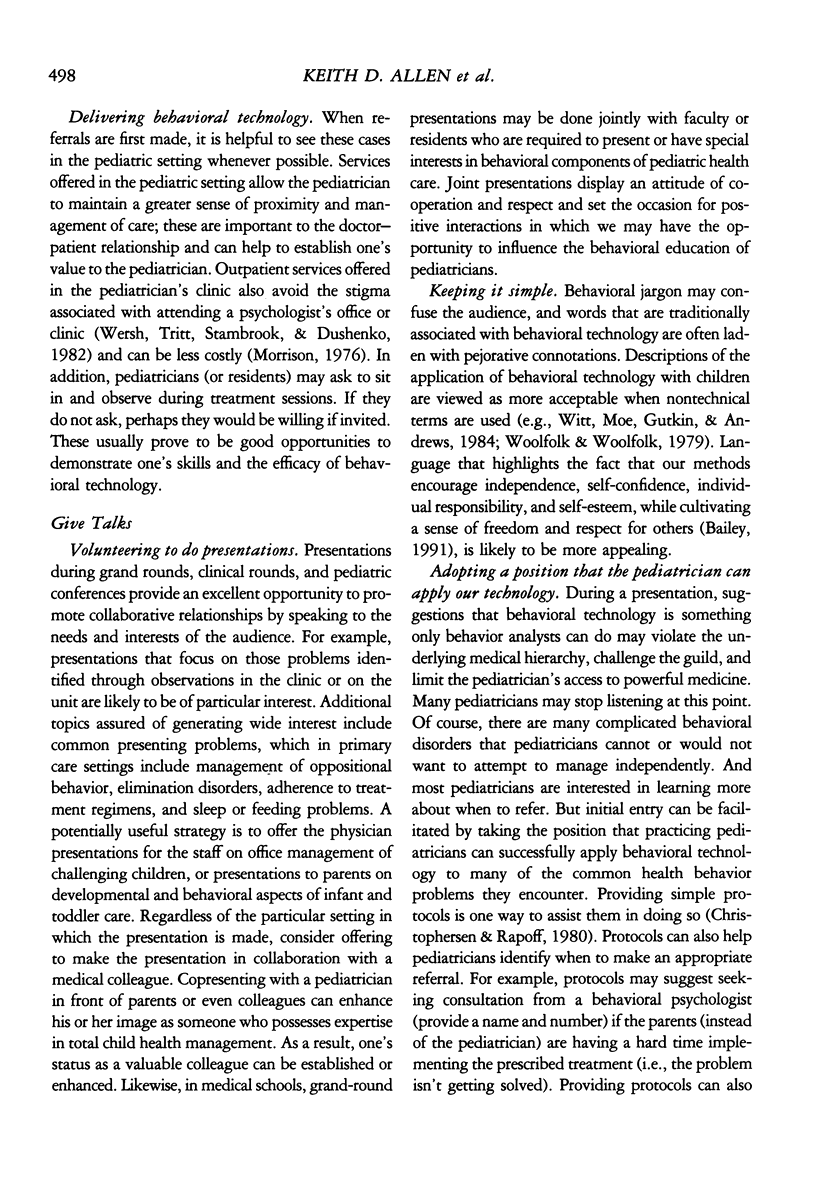
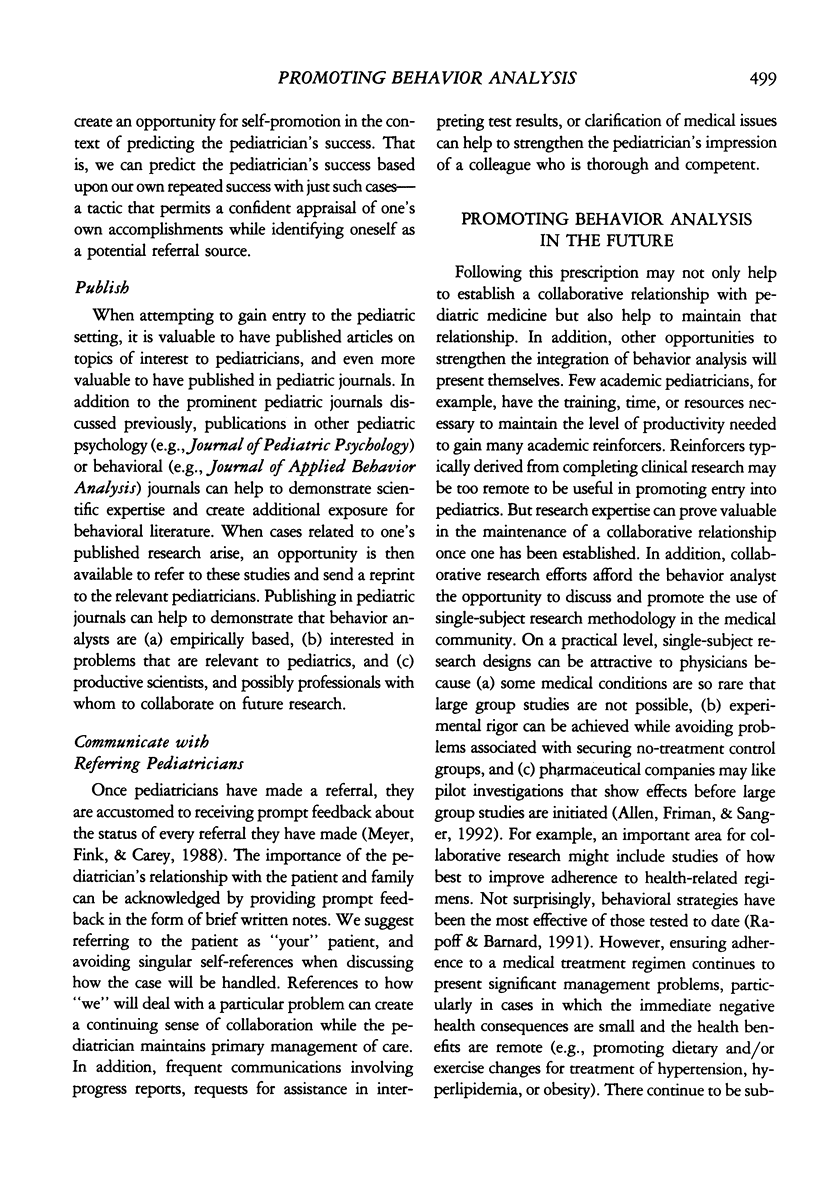
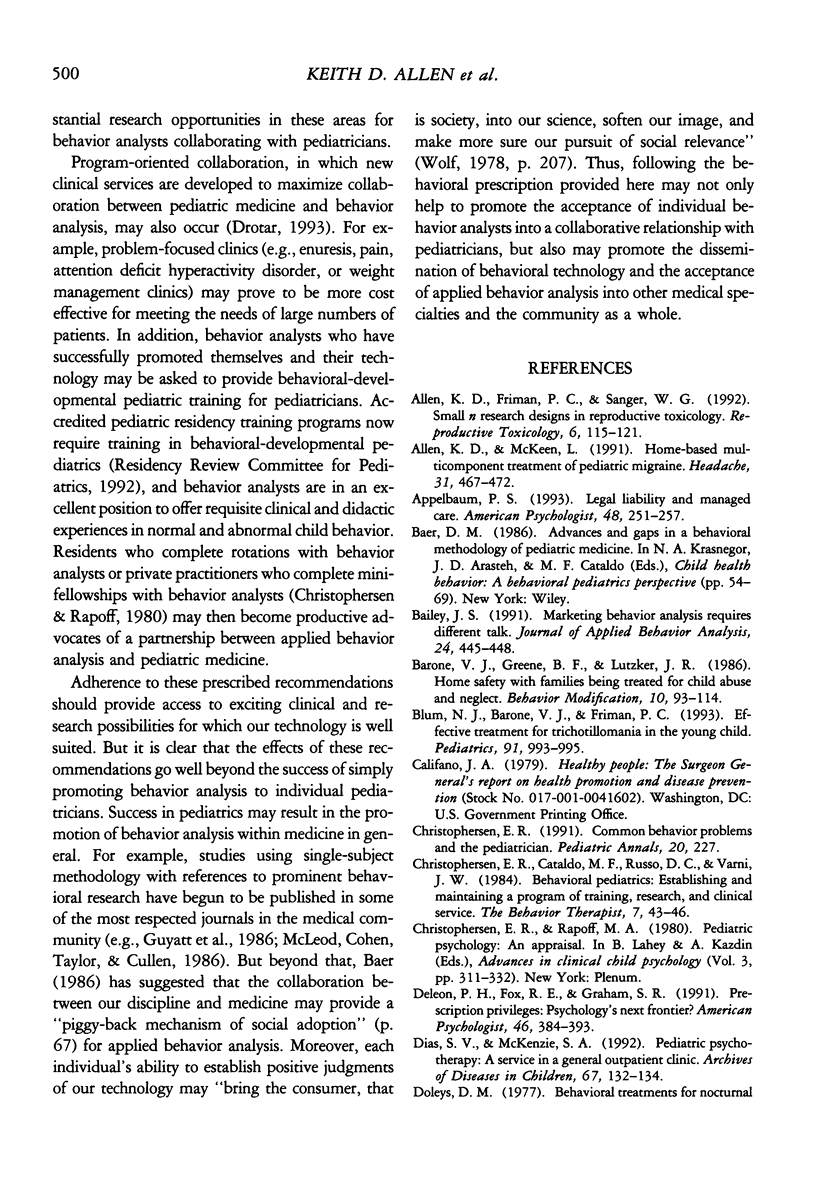
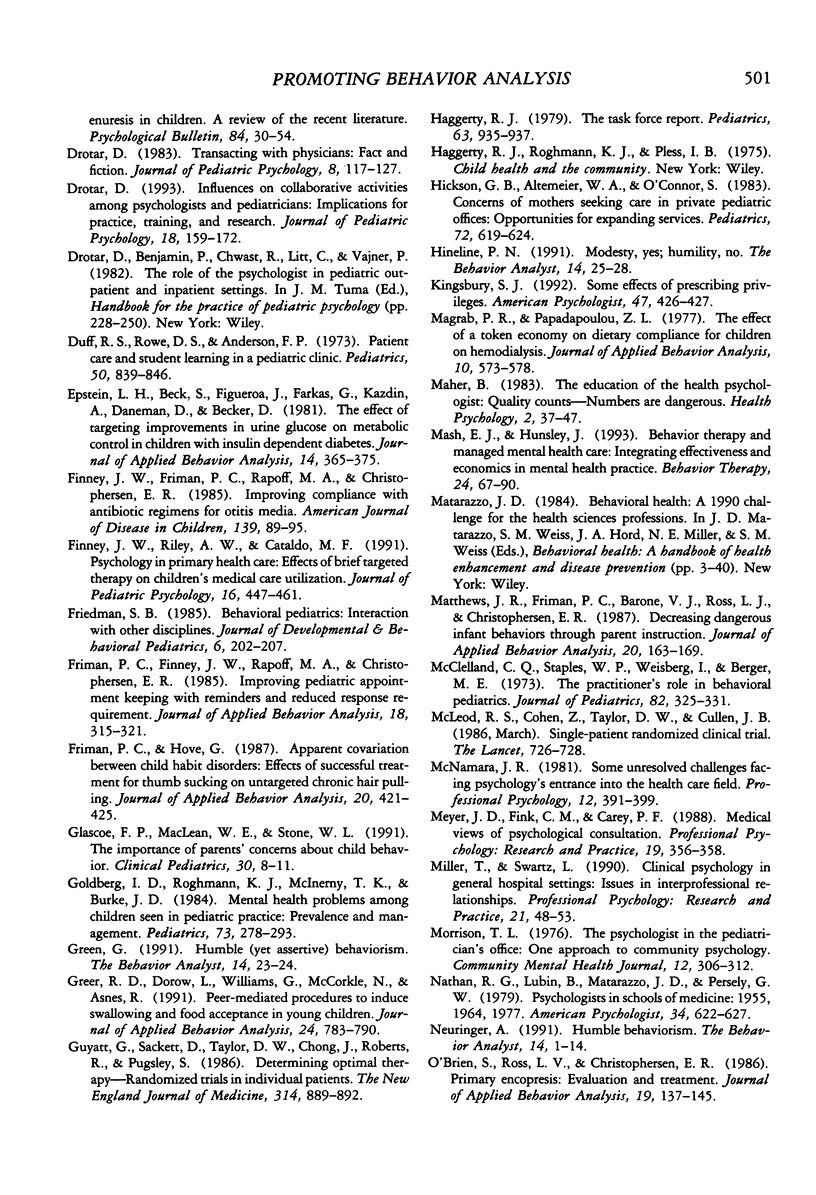
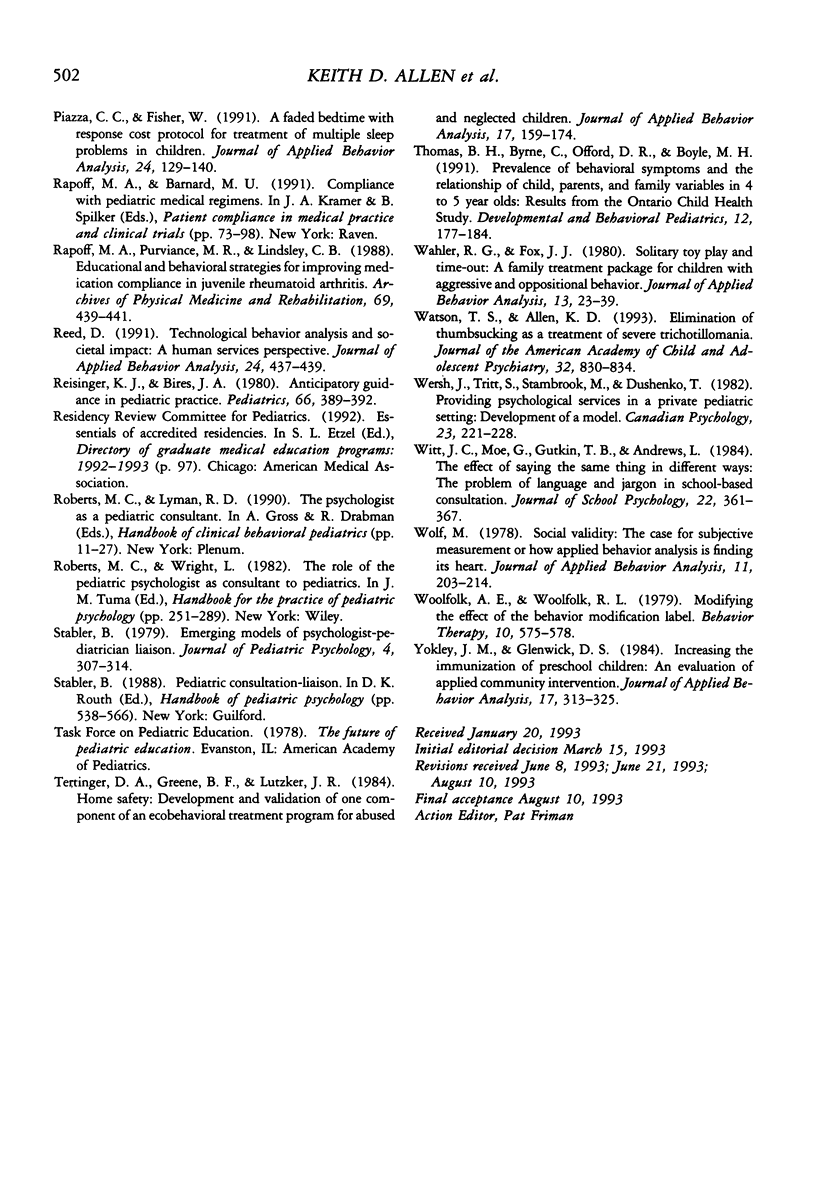
Selected References
These references are in PubMed. This may not be the complete list of references from this article.
- Allen K. D., Friman P. C., Sanger W. G. Small n research designs in reproductive toxicology. Reprod Toxicol. 1992;6(2):115–121. doi: 10.1016/0890-6238(92)90112-7. [DOI] [PubMed] [Google Scholar]
- Allen K. D., McKeen L. R. Home-based multicomponent treatment of pediatric migraine. Headache. 1991 Jul;31(7):467–472. doi: 10.1111/j.1526-4610.1991.hed3107467.x. [DOI] [PubMed] [Google Scholar]
- Appelbaum P. S. Legal liability and managed care. Am Psychol. 1993 Mar;48(3):251–257. doi: 10.1037//0003-066x.48.3.251. [DOI] [PubMed] [Google Scholar]
- Bailey J. S. Marketing behavior analysis requires different talk. J Appl Behav Anal. 1991 Fall;24(3):445–448. doi: 10.1901/jaba.1991.24-445. [DOI] [PMC free article] [PubMed] [Google Scholar]
- Barone V. J., Greene B. F., Lutzker J. R. Home safety with families being treated for child abuse and neglect. Behav Modif. 1986 Jan;10(1):93–114. doi: 10.1177/01454455860101006. [DOI] [PubMed] [Google Scholar]
- Blum N. J., Barone V. J., Friman P. C. A simplified behavioral treatment for trichotillomania: report of two cases. Pediatrics. 1993 May;91(5):993–995. [PubMed] [Google Scholar]
- Christophersen E. R. Common behavior problems and the pediatrician. Pediatr Ann. 1991 May;20(5):227–227. doi: 10.3928/0090-4481-19910501-05. [DOI] [PubMed] [Google Scholar]
- DeLeon P. H., Fox R. E., Graham S. R. Prescription privileges. Psychology's next frontier? Am Psychol. 1991 Apr;46(4):384–393. doi: 10.1037//0003-066x.46.4.384. [DOI] [PubMed] [Google Scholar]
- Doleys D. M. Behavioral treatments for nocturnal enuresis in children: a review of the recent literature. Psychol Bull. 1977 Jan;84(1):30–54. [PubMed] [Google Scholar]
- Drotar D. Influences on collaborative activities among psychologists and pediatricians: implications for practice, training, and research. J Pediatr Psychol. 1993 Apr;18(2):159–172. doi: 10.1093/jpepsy/18.2.159. [DOI] [PubMed] [Google Scholar]
- Drotar D. Transacting with physicians: fact and fiction. J Pediatr Psychol. 1983 Jun;8(2):117–127. doi: 10.1093/jpepsy/8.2.117. [DOI] [PubMed] [Google Scholar]
- Duff R. S., Rowe D. S., Anderson F. P. Patient care and student learning in a pediatric clinic. Pediatrics. 1972 Dec;50(6):839–846. [PubMed] [Google Scholar]
- Epstein L. H., Beck S., Figueroa J., Farkas G., Kazdin A. E., Daneman D., Becker D. The effects of targeting improvements in urine glucose on metabolic control in children with insulin dependent diabetes. J Appl Behav Anal. 1981 Winter;14(4):365–375. doi: 10.1901/jaba.1981.14-365. [DOI] [PMC free article] [PubMed] [Google Scholar]
- Finney J. W., Friman P. C., Rapoff M. A., Christophersen E. R. Improving compliance with antibiotic regimens for otitis media. Randomized clinical trial in a pediatric clinic. Am J Dis Child. 1985 Jan;139(1):89–95. doi: 10.1001/archpedi.1985.02140030095041. [DOI] [PubMed] [Google Scholar]
- Finney J. W., Riley A. W., Cataldo M. F. Psychology in primary health care: effects of brief targeted therapy on children's medical care utilization. J Pediatr Psychol. 1991 Aug;16(4):447–461. doi: 10.1093/jpepsy/16.4.447. [DOI] [PubMed] [Google Scholar]
- Friedman S. B. Behavioral pediatrics: interaction with other disciplines. J Dev Behav Pediatr. 1985 Aug;6(4):202–214. [PubMed] [Google Scholar]
- Friman P. C., Finney J. W., Rapoff M. A., Christophersen E. R. Improving pediatric appointment keeping with reminders and reduced response requirement. J Appl Behav Anal. 1985 Winter;18(4):315–321. doi: 10.1901/jaba.1985.18-315. [DOI] [PMC free article] [PubMed] [Google Scholar]
- Friman P. C., Hove G. Apparent covariation between child habit disorders: effects of successful treatment for thumb sucking on untargeted chronic hair pulling. J Appl Behav Anal. 1987 Winter;20(4):421–425. doi: 10.1901/jaba.1987.20-421. [DOI] [PMC free article] [PubMed] [Google Scholar]
- Glascoe F. P., MacLean W. E., Stone W. L. The importance of parents' concerns about their child's behavior. Clin Pediatr (Phila) 1991 Jan;30(1):8–14. doi: 10.1177/000992289103000101. [DOI] [PubMed] [Google Scholar]
- Goldberg I. D., Roghmann K. J., McInerny T. K., Burke J. D., Jr Mental health problems among children seen in pediatric practice: prevalence and management. Pediatrics. 1984 Mar;73(3):278–293. [PubMed] [Google Scholar]
- Greer R. D., Dorow L., Williams G., McCorkle N., Asnes R. Peer-mediated procedures to induce swallowing and food acceptance in young children. J Appl Behav Anal. 1991 Winter;24(4):783–790. doi: 10.1901/jaba.1991.24-783. [DOI] [PMC free article] [PubMed] [Google Scholar]
- Guyatt G., Sackett D., Taylor D. W., Chong J., Roberts R., Pugsley S. Determining optimal therapy--randomized trials in individual patients. N Engl J Med. 1986 Apr 3;314(14):889–892. doi: 10.1056/NEJM198604033141406. [DOI] [PubMed] [Google Scholar]
- Haggerty R. J. American Pediatric Society. The Task Force report. Pediatrics. 1979 Jun;63(6):935–937. [PubMed] [Google Scholar]
- Hickson G. B., Altemeier W. A., O'Connor S. Concerns of mothers seeking care in private pediatric offices: opportunities for expanding services. Pediatrics. 1983 Nov;72(5):619–624. [PubMed] [Google Scholar]
- Kingsbury S. J. Some effects of prescribing privileges. Am Psychol. 1992 Mar;47(3):426–427. doi: 10.1037//0003-066x.47.3.426. [DOI] [PubMed] [Google Scholar]
- Magrab P. R., Papadopoulou Z. L. The effect of a token economy on dietary compliance for children on hemodialysis. J Appl Behav Anal. 1977 Winter;10(4):573–578. doi: 10.1901/jaba.1977.10-573. [DOI] [PMC free article] [PubMed] [Google Scholar]
- Mathews J. R., Friman P. C., Barone V. J., Ross L. V., Christophersen E. R. Decreasing dangerous infant behaviors through parent instruction. J Appl Behav Anal. 1987 Summer;20(2):165–169. doi: 10.1901/jaba.1987.20-165. [DOI] [PMC free article] [PubMed] [Google Scholar]
- McClelland C. Q., Staples W. I., Weisberg I., Bergen M. E. The practitioner's role in behavioral pediatrics. J Pediatr. 1973 Feb;82(2):325–331. doi: 10.1016/s0022-3476(73)80183-0. [DOI] [PubMed] [Google Scholar]
- McLeod R. S., Taylor D. W., Cohen Z., Cullen J. B. Single-patient randomised clinical trial. Use in determining optimum treatment for patient with inflammation of Kock continent ileostomy reservoir. Lancet. 1986 Mar 29;1(8483):726–728. doi: 10.1016/s0140-6736(86)91112-8. [DOI] [PubMed] [Google Scholar]
- Morrison T. L. The psychologist in the pediatrician's office: one approach to community psychology. Community Ment Health J. 1976 Fall;12(3):300–312. doi: 10.1007/BF01419759. [DOI] [PubMed] [Google Scholar]
- Nathan R. G., Lubin B., Matarazzo J. D., Persely G. W. Psychologists in schools of medicine: 1955, 1964, and 1977. Am Psychol. 1979 Jul;34(7):622–627. doi: 10.1037//0003-066x.34.7.622. [DOI] [PubMed] [Google Scholar]
- O'Brien S., Ross L. V., Christophersen E. R. Primary encopresis: evaluation and treatment. J Appl Behav Anal. 1986 Summer;19(2):137–145. doi: 10.1901/jaba.1986.19-137. [DOI] [PMC free article] [PubMed] [Google Scholar]
- Piazza C. C., Fisher W. A faded bedtime with response cost protocol for treatment of multiple sleep problems in children. J Appl Behav Anal. 1991 Spring;24(1):129–140. doi: 10.1901/jaba.1991.24-129. [DOI] [PMC free article] [PubMed] [Google Scholar]
- Rapoff M. A., Purviance M. R., Lindsley C. B. Educational and behavioral strategies for improving medication compliance in juvenile rheumatoid arthritis. Arch Phys Med Rehabil. 1988 Jun;69(6):439–441. [PubMed] [Google Scholar]
- Reid D. H. Technological behavior analysis and societal impact: A human services perspective. J Appl Behav Anal. 1991 Fall;24(3):437–439. doi: 10.1901/jaba.1991.24-437. [DOI] [PMC free article] [PubMed] [Google Scholar]
- Tertinger D. A., Greene B. F., Lutzker J. R. Home safety: development and validation of one component of an ecobehavioral treatment program for abused and neglected children. J Appl Behav Anal. 1984 Summer;17(2):159–174. doi: 10.1901/jaba.1984.17-159. [DOI] [PMC free article] [PubMed] [Google Scholar]
- Thomas B. H., Byrne C., Offord D. R., Boyle M. H. Prevalence of behavioral symptoms and the relationship of child, parent, and family variables in 4- and 5-year-olds: results from the Ontario Child Health Study. J Dev Behav Pediatr. 1991 Jun;12(3):177–184. [PubMed] [Google Scholar]
- Vas Dias S., McKenzie S. A. Paediatric psychotherapy: a service in a general outpatient clinic. Arch Dis Child. 1992 Jan;67(1):132–134. doi: 10.1136/adc.67.1.132. [DOI] [PMC free article] [PubMed] [Google Scholar]
- Wahler R. G., Fox J. J. Solitary toy play and time out: a family treatment package for children with aggressive and oppositional behavior. J Appl Behav Anal. 1980 Spring;13(1):23–39. doi: 10.1901/jaba.1980.13-23. [DOI] [PMC free article] [PubMed] [Google Scholar]
- Watson T. S., Allen K. D. Elimination of thumb-sucking as a treatment for severe trichotillomania. J Am Acad Child Adolesc Psychiatry. 1993 Jul;32(4):830–834. doi: 10.1097/00004583-199307000-00019. [DOI] [PubMed] [Google Scholar]
- Wolf M. M. Social validity: the case for subjective measurement or how applied behavior analysis is finding its heart. J Appl Behav Anal. 1978 Summer;11(2):203–214. doi: 10.1901/jaba.1978.11-203. [DOI] [PMC free article] [PubMed] [Google Scholar]
- Yokley J. M., Glenwick D. S. Increasing the immunization of preschool children; an evaluation of applied community interventions. J Appl Behav Anal. 1984 Fall;17(3):313–325. doi: 10.1901/jaba.1984.17-313. [DOI] [PMC free article] [PubMed] [Google Scholar]


